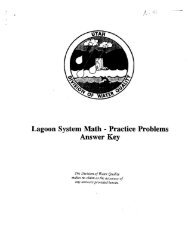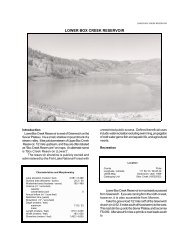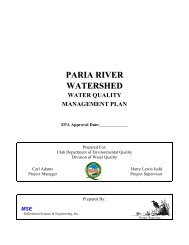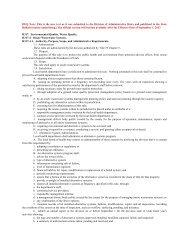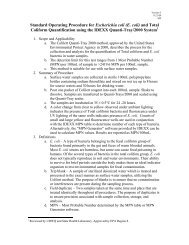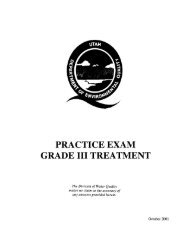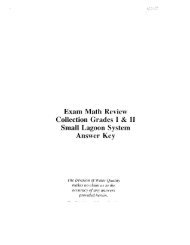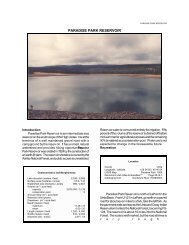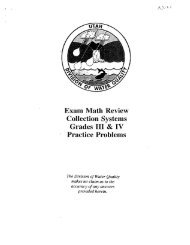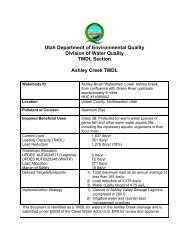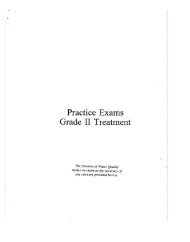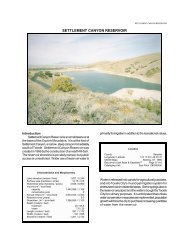Aquifer Recharge, Storage, and Recovery - Southwest Hydrology ...
Aquifer Recharge, Storage, and Recovery - Southwest Hydrology ...
Aquifer Recharge, Storage, and Recovery - Southwest Hydrology ...
- No tags were found...
Create successful ePaper yourself
Turn your PDF publications into a flip-book with our unique Google optimized e-Paper software.
R & DDire Predictions for ColoradoRiver ReservoirsThere is a 50 percent chance live storage(water that can be evacuated by gravity)in lakes Mead <strong>and</strong> Powell will be gone by2021 if climate changes occur as expected<strong>and</strong> no changes in water managementstrategies are made, according to TimBarnett <strong>and</strong> David Pierce at ScrippsInstitution of Oceanography at theUniversity of California, San Diego.Furthermore, the reservoirs have a 50percent chance of dropping too low toallow hydroelectric power generationby 2017. The researchers performedtheir analysis using a simple waterbudget model <strong>and</strong> reported their findingsin a paper accepted for publicationin Water Resources Research.The release of the report generatedheadlines across the country, <strong>and</strong> somecontroversy. Among the scientificcommunity, disagreement with the study’s34 • May/June 2008 • <strong>Southwest</strong> <strong>Hydrology</strong>approach appears to center on whetherthe climate prediction models used bythe Scripps researchers are sensitiveenough at the regional scale to makeaccurate predictions. The U.S. Bureauof Reclamation recently completed anextensive analysis of Colorado Riverbasin flows, but its researchers based theiranalyses on tree-ring data to considerthe range of historic flows over the last1,200 years, rather than climate models,which they deemed not scalable to localeffects. Disagreement—often colorful—also came from water managers whosaid the findings are overly alarming:managers would take steps to preventthe dire predictions from coming true.According to a Scripps news release,the researchers were conservative. Theybased their findings on the premise thatclimate change effects started in 2007,even though most scientists considerhuman-caused changes in climate to havestarted decades earlier. They based theirColorado River flow on the 100-yearaverage, although actually it has fallen inrecent decades <strong>and</strong> the 500-year averageis even lower. Even if water agenciesfollow their current drought contingencyplans, they found, it might not be enoughto counter natural forces, especially ifthe region enters a period of sustaineddrought or human-induced climatechanges occur as currently predicted.Check back in 15 years…Visit scrippsnews.ucsd.edu/Releases/?releaseID=876or www.agu.org (members only).Mussel UpdateYou wouldn’t think mussels that moveat a snail’s pace would be able to crossthe country like birds <strong>and</strong> reproducelike rabbits, but it appears that is what’shappening. It was only in January 2007that the first quagga mussels west of theMississippi River were confirmed in LakeMead (see <strong>Southwest</strong> <strong>Hydrology</strong>, Jul/Aug2007 <strong>and</strong> Nov/Dec 2007). But in the lastseveral months, news of the invasionhas become worse: the prolific quaggasthat clog pipelines <strong>and</strong> machinery <strong>and</strong>upset ecosystems appear to be thrivingin the Colorado River Basin, <strong>and</strong> theircousins, the zebra mussels (both genusDreissena), has also invaded the West.In February, the Las Vegas Review Journalreported that the quaggas in Lake Havasu<strong>and</strong> other reservoirs are reproducingthree times faster than those in the GreatLakes area, at a rate of six times per yearrather than two, according to Bureauof Reclamation quagga coordinatorLeonard Willett. He estimated the costto manage the mussel population <strong>and</strong>maintain operations in Hoover Damalone could reach $1 million per year.Without control, quaggas can clog coolingpipes, causing turbines to overheat, saidthe newspaper. Control options underconsideration are a soil bacterium thattargets quaggas (still in development),filters, chemicals such as chlorine, <strong>and</strong>ultraviolet light. However, most of



